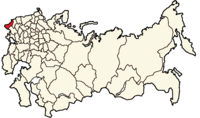This is an old revision of this page, as edited by Ionas Aurelian Rus (talk | contribs) at 03:04, 7 June 2022. The present address (URL) is a permanent link to this revision, which may differ significantly from the current revision.
Revision as of 03:04, 7 June 2022 by Ionas Aurelian Rus (talk | contribs)(diff) ← Previous revision | Latest revision (diff) | Newer revision → (diff)| Bessarabia | |
|---|---|
| Former Civilian constituency for the All-Russian Constituent Assembly | |
 | |
| Former constituency | |
| Created | 1917 |
| Abolished | 1918 |
| Number of members | 13 |
| Number of Uyezd Electoral Commissions | 8 |
| Number of Urban Electoral Commissions | 2 |
| Number of Parishes | 225 |
| Sources: | |
The Bessarabia electoral district (Template:Lang-ru) was a constituency created for the 1917 Russian Constituent Assembly election.
The electoral district covered the Bessarabia Governorate. Oliver Radkey's account is substantially incomplete. According to Radkey, only the results from Chișinău and 3 out of 8 uezds could be gathered by scholars. The 5 uezds left out of the count were more populous. Two other sets have been published: one by Moldovan historian Gheorghe Cojocaru, providing a detailed account of the civilian votes, covering almost two thirds of the ones cast in Bessarabia, and a reportedly complete set provided by Soviet author G. Ustinov. 17 lists were in the fray in Bessarabia. The demographics of the district were divided between Rumanians (48%), Ukrainians (20%) and Russians (8%). Among the elected deputies, SR deputies were Jewish or Russian, while the peasant soviet deputies, who were in favor of Bessarabia's autonomy, largely for the benefit of the Moldovan/Romanian population, were Romanian.
Results
|
|
According to Gheorghe Cojocaru, out of 401,230 votes, the Soviet of Peasants' Deputies obtained 147,200 votes (36.7%), the Socialist Revolutionaries 125,098 votes (31.2%), the Jewish National Electoral Committee 42,506 votes (10.6%), the Bolsheviks and Menshevik Internationalists 27,722 (6.9%), the Moldovan National Party and the Bessarabian Union of Credit and Savings Associations 8,816 votes (2.2%), the Ukrainian Socialist Organizations 16,210 (4%), the Kadets 18,073 votes (4.5% of the votes), the Union of Landowners 6,022 votes (1.5%), the Bund/Mensheviks 3,388 votes (0.8%), the Bessarabian Popular Socialist Labour Party 1,206 votes (0.3%), the Socialist Party of the Workers of the South-East Railway 488 votes (0.1%), the Union of Citizens of German Nationality votes 1670 (0.4%), the Cooperative Group 2,518 votes (0.6%), the 3rd section of the Telitsky volost of Bendery uezd 29 votes (0%), inhabitants of Telitsky volost 20 votes (0%), the 4th section of the Telitsky volost 30 votes (0.0%), and Poalei Zion 1,629 votes (0.4%).
As per Victor Serge, some 600,000 people took part in the vote, with the Peasant soviet obtaining some 200,000 votes, SRs 229,000 votes, Jewish national list 60,000, Kadets 40,000 and the Moldavian National Party 14,000.
In Chișinău city the Jewish National Electoral Committee got 9,054 votes (31.3%), SRs got 5,617 votes (19.4%), the Bolsheviks 5,449 votes (18.8%), the Kadets 3,024 votes (10.5%), the Union of Landowners 1,956 votes (6.8%), the Menshevik-Bund alliance 1,441 votes (5%), the Ukrainian list 1,088 votes (3.8%), the peasants list 472 votes (1.6%), the Moldovan National Party 407 votes (1.4%), the Popular Socialists 276 votes (0.9%), Poalei Zion 51 votes (0.2%), the German list 47 votes (0.2%), the Socialist Party of the Railway Workers 33 votes (0.1%), the cooperative list 11 votes and 16 votes for the remaining 3 lists. Some 12,000 votes were cast in the Chișinău garrison (60% voter turnout); The Internationalist list got 4,859 votes, the SRs 4,689 votes, 845 for the Ukrainian socialists and 704 for the Kadets.
References
- И. С. Малчевский (1930). Всероссийское учредительное собрание. Гос изд-во. pp. 140–142.
- Б. Ф Додонов; Е. Д Гринько; О. В.. Лавинская (2004). Журналы заседаний Временного правительства: Сентябрь-октябрь 1917 года. РОССПЭН. pp. 206–208. ISBN 9785824305548.
- Татьяна Евгеньевна Новицкая (1991). Учредительное собрание: Россия 1918 : стенограмма и другие документы. Недра. p. 13.
- Oliver Henry Radkey (1989). Russia goes to the polls: the election to the all-Russian Constituent Assembly, 1917. Cornell University Press. p. 24. ISBN 978-0-8014-2360-4.
- ^ Oliver Henry Radkey (1989). Russia goes to the polls: the election to the all-Russian Constituent Assembly, 1917. Cornell University Press. pp. 107–110. ISBN 978-0-8014-2360-4.
- Oliver Henry Radkey (1989). Russia goes to the polls: the election to the all-Russian Constituent Assembly, 1917. Cornell University Press. pp. 161–163. ISBN 978-0-8014-2360-4.
- ^ Rus, Ionaș Aurelian (2009). "The Roots and Early Development of Moldovan-Romanian Nationalism in Bessarabia (1900–1917)". Romanian Review of Political Sciences and International Relations. VI (2): 17–19, at http://citeseerx.ist.psu.edu/viewdoc/download?doi=10.1.1.455.5649&rep=rep1&type=pdf#page=8. ISSN 2285-2107.
- Oliver Henry Radkey (1989). Russia goes to the polls: the election to the all-Russian Constituent Assembly, 1917. Cornell University Press. pp. 148–160. ISBN 978-0-8014-2360-4.
- ^ Л. М Спирин (1987). Россия 1917 год: из истории борьбы политических партий. Мысль. pp. 273–328.
- Лев Григорьевич Протасов (2008). Люди Учредительного собрания: портрет в интерьере эпохи. РОССПЭН. ISBN 978-5-8243-0972-0.
- Gheorghe Cojocaru, "Cu Privire la Problema Adunarii Constituante in Basarabia in Anul 1917 (II)" , in Revista de Istorie a Moldovei ("Review of the History of Moldova"), 1991, no. 3 (July-September), p. 14.
- Victor Serge (15 January 2017). Year One of the Russian Revolution. Haymarket Books. p. 432. ISBN 978-1-60846-609-2.
- Leonard Mikhaĭlovich Gavrilov; Institut istorii (Akademii︠a︡ nauk SSSR) (1962). Borʹba za ustanovlenie i uprochenie sovetskoĭ vlasti: khronika sobytiĭ, 26 okti︠a︡bri︠a︡ 1917 g.-10 i︠a︡nvari︠a︡ 1918 g. Izd-vo Akademii nauk SSSR. p. 282.
| Electoral Districts of the 1917 Russian Constituent Assembly election | ||
|---|---|---|
| Northern/Northwestern |  | |
| Baltic/White Russian | ||
| Central Industrial | ||
| Central Black Earth | ||
| Volga | ||
| Kama-Ural | ||
| Ukraine | ||
| Southern-Black Sea/Southeastern | ||
| Caucasus | ||
| Turkestan | ||
| Siberia | ||
| Military districts | ||